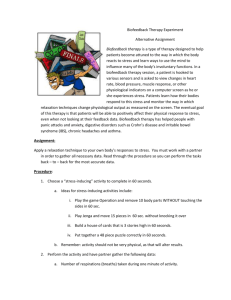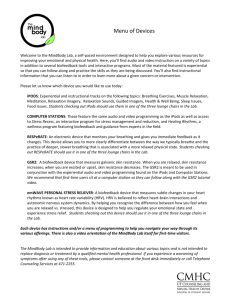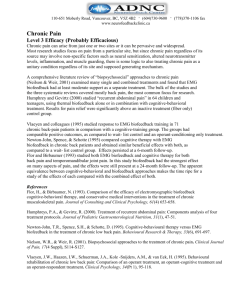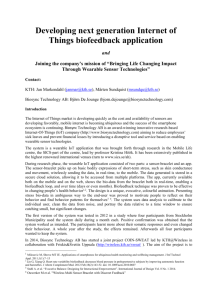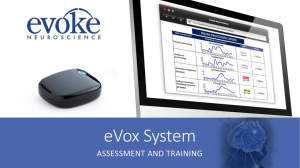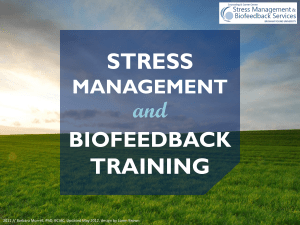Randomised Controlled Trial for Low Back Pain • AT 10 WEEKS
advertisement
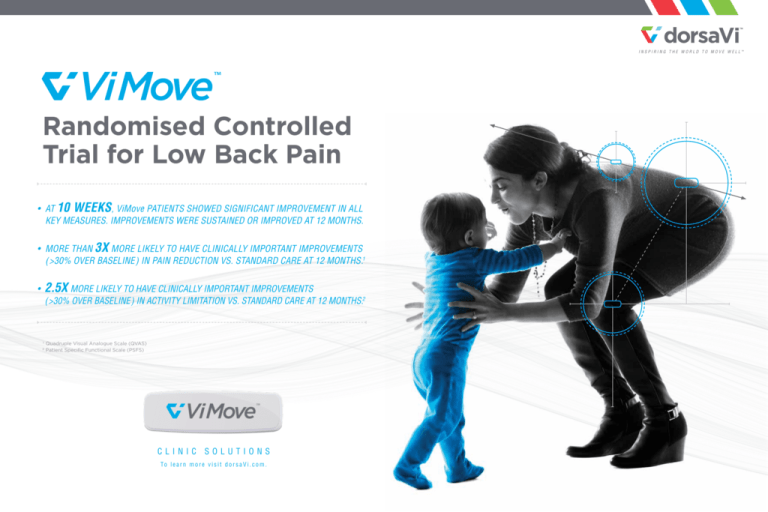
INSPIRING THE WORLD TO MOVE WELL™ Randomised Controlled Trial for Low Back Pain • A T 10 WEEKS, ViMove PATIENTS SHOWED SIGNIFICANT IMPROVEMENT IN ALL KEY MEASURES. IMPROVEMENTS WERE SUSTAINED OR IMPROVED AT 12 MONTHS. • MORE THAN 3X MORE LIKELY TO HAVE CLINICALLY IMPORTANT IMPROVEMENTS ( >30% OVER BASELINE ) IN PAIN REDUCTION VS. STANDARD CARE AT 12 MONTHS.1 • 2 .5X MORE LIKELY TO HAVE CLINICALLY IMPORTANT IMPROVEMENTS (>30% OVER BASELINE) IN ACTIVITY LIMITATION VS. STANDARD CARE AT 12 MONTHS.2 1 2 Quadruple Visual Analogue Scale (QVAS) Patient Specific Functional Scale (PSFS) CLINIC SOLUTIONS To l e a r n m o r e v i s i t d o r s a V i . c o m . Kent et al. BMC Musculoskeletal Disorders (2015) 16:131 DOI 10.1186/s12891-015-0591-5 RESEARCH ARTICLE Open Access The effect of changing movement and posture using motion-sensor biofeedback, versus guidelines-based care, on the clinical outcomes of people with sub-acute or chronic low back pain-a multicentre, cluster-randomised, placebo-controlled, pilot trial ViMove MUSCLE ACTIVITY SENSORS / ACTUAL SIZE Peter Kent1,2*, Robert Laird3 and Terry Haines3,4 Abstract Background: The aims of this pilot trial were to (i) test the hypothesis that modifying patterns of painful lumbo-pelvic movement using motion-sensor biofeedback in people with low back pain would lead to reduced pain and activity limitation compared with guidelines-based care, and (ii) facilitate sample size calculations for a fully powered trial. Methods: A multicentre (8 clinics), cluster-randomised, placebo-controlled pilot trial compared two groups of Study Aim: What’s theprimary impact of and treating back patients seeking medical or physiotherapy care for sub-acute chronic back pain.low It was powered for longitudinal analysis, but not for adjusted single-time point comparisons. The intervention group (n = 58) received patients with ViMove vs.byGuidelines-Based Care? modification of movement patterns augmented motion-sensor movement biofeedback (ViMove, dorsaVi.com) plus guidelines-based medical or physiotherapy care. The control group (n = 54) received a placebo (wearing the motion-sensors without biofeedback) plus guidelines-based medical or physiotherapy care. Primary outcomes were self-reported pain intensity (VAS) and activity limitation (Roland Morris Disability Questionnaire (RMDQ), Patient Specific Functional Scale (PSFS)), all on 0–100 scales. Both groups received 6–8 treatment sessions. Outcomes were measured seven times during 10-weeks of treatment and at 12, 26 and 52 week follow-up, with 17.0 % dropout. Patients were not informed of group allocation or the study hypothesis. 10 WEEKS OF TREATMENT. ONE YEAR OF FOLLOW-UP. ViMove MOVEMENT SENSORS / ACTUAL SIZE Results: Across one-year, there were significant between-group differences favouring the intervention group ViMove is a wireless medical device that measures, records, and reports Primary Endpoints [generalized linear model coefficient (95 % CI): group effect RMDQ −7.1 (95 % CI–12.6;–1.6), PSFS −10.3 (−16.6; −3.9), QVAS −7.7 (−13.0; −2.4); and group by time effect differences (per 100 days) RMDQ −3.5 (−5.2; −2.2), PSFS −4.7 (−7.0; −2.5), QVAS −4.8 (−6.1; −3.5)], all p < 0.001. Risk ratios between groups of probability of improving by >30 % 12-months = RMDQ 2.4 (95 % CI 1.5; 4.1), PSFS 2.5 (1.5; 4.0), QVAS 3.3 (1.8; 5.9). PAIN:at The only device-related side-effects involved transient skin irritation from tape used to mount motion sensors. movements and muscle activity of the lower back / lumbar spine. The system also measures range of motion in the sagittal and coronal anatomical planes. (Continued on next page) • Change over time from baseline of severity of pain measured by the Quadruple Visual Analogue Scale (QVAS) * Correspondence: pkent@health.sdu.dk 1 Institute of Sports Science and Clinical Biomechanics, University of Southern ACTIVITY LIMITATION: Denmark, Campusvej 55, Odense M, 5230, Denmark 2 • Research Department, Spine Centre of Southern Denmark, Hospital Lillebaelt, Institute of Regional Health Services Research, University of Southern Denmark, Middelfart, Denmark list oftime authorfrom information is available the end of the article ChangeFull over baseline in atactivity limitation, measured by the Rolland Morris Disability Questionnaire (RMDQ-23) © 2015 Kent et al.; licensee BioMed Central. This is an Open Access article distributed under the terms of the Creative Attribution License (http://creativecommons.org/licenses/by/4.0), which permits Function unrestricted use,Scale distribution, and • Change over time from baseline inCommons activity limitation measured by the Patient Specific (PSFS) reproduction in any medium, provided the original work is properly credited. The Creative Commons Public Domain Dedication waiver (http://creativecommons.org/publicdomain/zero/1.0/) applies to the data made available in this article, unless otherwise stated. Study Design Interventions during the trial: Treatment Arm vs Control Both arms received standard guidelines based care including advice on staying healthy and general self-management, of back pain. All participants wore ViMove sensors 4-10 hours in their activities of daily living during and after each CLUSTERS N=8 CENTERS RANDOMISED PATIENTS N=112 ENROLLMENT treatment session over 10 weeks (6-8 times). Control arm wore placebo sensors. ViMove TREATMENT ARM INTERVENTION: ViMove 4 CENTERS RANDOMISED PATIENTS N=58 BASELINE GUIDELINES-BASED CARE 4 CENTERS RANDOMISED PATIENTS N=54 ViMove LIVE ASSESSMENT TREATMENT & FOLLOW-UPS 6-8 TREATMENTS OVER 10 WEEKS FOLLOW-UPS AT 3, 6, 12 MONTHS 6-8 TREATMENTS OVER 10 WEEKS FOLLOW-UPS AT 3, 6, 12 MONTHS Individualised ViMove guided assessment of movement to determine connection between movement and pain. Assessment drove patient-tailored specific rehabilitation strategies. ViMove LIVE TRAINING Sensors were worn by patients outside clinic and data collected on % time slouching, sitting/standing, and degrees in flexion to guide clinician care. ViMove MONITORING Wearing ViMove sensors and watching real-time graphical feedback on movement, patients were instructed on how to alter movements patterns to avoid pain. ViMove BIOFEEDBACK Sensors worn by patients during daily living. Using ViMove software, clinicians could easily program motion sensor biofeedback alerts (audio, vibration) to alert if patient exceeded a desired range of motion. Patients were then alerted, by ViMove sensors when they “broke a rule” that clinician had programmed. Inclusion Criteria Participants meeting all of the following criteria were eligible for participation in the study: 1. Provision of written informed consent. 2. Between 18 and 65 years of age. 3. At least moderate intensity lower back pain (LBP) as defined by a QVAS score > 3 out of 10 (or 30mm out of 100mm) (Carragee & Chen, Spine 2000). 4. Identified by the Investigator as Sub-Acute (3 to 12 weeks post onset of LBP) or Chronic (> 12 weeks post onset of LBP). See FAQ for Exclusion Criteria. Study Results Patient Specific Functional Scale (PSFS) ViMove PATIENTS 2.5X MORE LIKELY TO HAVE CLINICALLY IMPORTANT IMPROVEMENTS VS STANDARD CARE AT 12 MONTHS* “These results are unusual and encouraging because they show moderate to large effects at the end of the 10-week treatment period that remained or increased at the 12 month follow-up, in a health condition where interventions typically show small 80 GUIDELINES-BASED CARE GROUP 70 MOVEMENT BIOFEEDBACK GROUP The PSFS is a scale used to assess functional activity 60 where participants are asked to identify three functional 50 activities that were important to them and with which they were experiencing some activity limitation. 40 On a Scale of 0-10, participants scored from “0” 30 to moderate effects that are not sustained 12 months later.” - STUDY AUTHORS (unable to perform activity) to “10” (able to perform 20 activity at the same level as before injury or problem) 10 for each of the activities. Raw scores were proportionally recalculated and reversed to create 0 0 3 6 8 10 12 26 52 100 = maximum activity limitation).** TIME (WEEKS) Mean outcomes for activity limitation (Roland Morris Disability Questionnaire scores) * Unadjusted risk ratios “Clinically important events” defined as >30% improvement vs baseline Roland Morris Disability Questionnaire 23 (RMDQ-23) ViMove PATIENTS 2.4X MORE LIKELY TO HAVE CLINICALLY IMPORTANT IMPROVEMENTS VS STANDARD CARE AT 12 MONTHS* GUIDELINES-BASED CARE GROUP 80 MOVEMENT BIOFEEDBACK GROUP 70 The Roland Morris Disability Questionnaire 23 was 60 used to assess the subject’s functional ability. This 50 40 30 questionnaire asks 23 questions relating to the subject’s 0 10 12 26 52 TIME (WEEKS) Mean outcomes for activity limitation (Roland Morris Disability Questionnaire scores) “Clinically important events” defined as >30% improvement vs baseline GUIDELINES-BASED CARE GROUP 80 MOVEMENT BIOFEEDBACK GROUP 70 The QVAS is a scale that measures levels of 60 pain and consists of four questions each with 50 a horizontal line of 100 mm in length below activities. Participants responded either “Yes” or “No” 30 possible pain). The participant marked on the into a 0–100 scale (0 = no activity limitation, 6 8 IMPORTANT IMPROVEMENTS VS STANDARD CARE AT 12 MONTHS* and a scale of “0” (no pain) to “100” (worst recalculation, RMDQ-23 scores were transformed 0 3 Quadruple Visual Analogue Scale (QVAS) ViMove PATIENTS 3.3X MORE LIKELY TO HAVE CLINICALLY activities of daily living and their ability to perform these and a score of “0” applied to “No.” Using proportional 10 ** Lower score indicates better movement function 40 to each question, with a score of “1” applied to “Yes” 20 a 0–100 scale (0 = no activity limitation, 100 = maximum activity limitation).** * Unadjusted risk ratios ** Lower score indicates better movement function line the point that they felt represented their 20 perception of their pain. The anchors for all four questions were 0 = “no pain” and 10 0 100 = “worst possible pain.”** 0 3 6 8 10 26 52 TIME (WEEKS) Mean outcomes for activity limitation (Roland Morris Disability Questionnaire scores) “Clinically important events” defined as >30% improvement vs baseline * Unadjusted risk ratios ** Lower score indicates reduction in pain intensity Medication usage and other interventions “For LBP analgesics use, there was a significant group-by-time effect. For every 10 days in the 72 day treatment period, the proportion of days reported taking analgesics reduced by 0.007 more in the Movement Biofeedback Group, than in the Guidelines-Based Care Group.” “There were significant group and group-by-time effects on the number of pain and medication free days. The proportion of pain and analgesics medication free days over the 72 day treatment period was 0.042 more in the Movement Biofeedback Group than in the Guidelines-Based Care Group. Also, for every 10 days in the treatment period, the proportion of days reported as not having pain or taking any analgesics increased by 0.004 more in the Movement Biofeedback Group than in the Guidelines-Based Care Group.” - STUDY AUTHORS Co-Interventions received during intervention period MOVEMENT BIOFEEDBACK GROUP GUIDELINES-BASED CARE GROUP Intervention Type Number of patients receiving each intervention type Mean number of treatments per patient Number of patients receiving each intervention type Mean number of treatments per patient Advice or education 18 (31.0 %) 0.58 (SD 1.02) 19 (35.2 %) 1.48 (SD 2.62) Exercise 32 (55.2 %) 1.40 (SD 1.77) 40 (74.1 %) 4.78 (SD 3.25) Imaging 3 (5.2 %) 0.07 (SD 0.32) 8 (14.8 %) 0.13 (SD 0.34) Manual Therapy 36 (62.1 %) 1.89 (SD 1.98) 30 (55.6 %) 1.26 (SD1.73) Medication 6 (10.3 %) 0.16 (SD 0.53) 36 (66.7 %) 2.91 (SD 2.96) Other 15 (25.9 %) 0.35 (SD 0.74) 8 (14.8 %) 0.20 (SD 0.56) Taping or Bracing 1 (1.7 %) 0.02 (SD 0.13) 2 (3.7 %) 0.02 (SD 0.14) Frequently Asked Questions WHY DID THE STUDY INVESTIGATORS CHOOSE A CLUSTER RANDOMISED TRIAL DESIGN? WHAT WERE THE EXCLUSION CRITERIA FOR THE TRIAL? The investigators believed there was a reasonable possibility of contamination in the control group (ViMove disabled) thus Exclusion criteria included the following conditions: blinding was not considered feasible. The eight sites were randomly assigned to treatment group (ViMove) or control 1. Lower back surgery within previous 12 months. group (ViMove disabled) with all participants at the site being in the same group. All randomisation was performed by 2. Pregnant females. an independent statistician. 3. Participants with a severe hearing impairment. 4. E vidence of non-mechanical contributing cause for LBP (e.g. neoplasm, infection, fracture, inflammatory disorder). HOW LONG DID SUBJECTS WEAR THE SENSORS DURING TREATMENT SESSIONS? 5. Preceding chronic neurological changes (sub-acute group only). All participants wore the ViMove movement sensor system for 4 - 10 hours during and after each treatment session 6. Implanted electrical medical device (spinal cord stimulator, intrathecal pump, pacemaker or peripheral nerve stimulator) (6-8 times) over the 10-week treatment period. 7. Nerve block, spinal injection, or anesthetic procedure for the treatment of lower back pain, within 12 months of the study. HOW OFTEN WERE THE PAIN AND FUNCTIONAL SURVEYS ADMINISTERED TO PATIENTS? The surveys were administered to patients at baseline and throughout the trial to track progress. The surveys administered includes the following evidence-based instruments: 8. S ignificant medical abnormalities or conditions that in the opinion of the Investigator would interfere either with the ability to complete the study or the evaluation of the investigational device’s safety and efficacy. 9. R ecent history of a significant medical-surgical intervention that in the judgment of the Investigator would interfere either with the ability to complete the study or the evaluation of the investigative device’s safety and efficacy. • The Roland Morris Disability Questionnaire (RMDQ-23): Initial Assessment, Weeks 1, 3, 6, 8, 12, 26, 52 10. Known allergy (skin reaction) to tapes and plasters. • Patient Specific Functional Scale (PSFS): Initial Assessment, Weeks 1, 3, 6, 8, 12, 26, 52 11. Currently enrolled in an investigational drug or device study. • Quadruple Visual Analogue Scale (QVAS): Initial Assessment, Weeks 1, 3, 6, 8, 12, 26, 52 • Fear and Avoidance Beliefs Questionnaire (FABQ): Initial Assessment, Weeks 6 and 12 • Daily Pain Score: Initial Assessment; Daily Diary • Participants Global Impression of Change (PGIC): Week 52 WERE THERE ADVERSE EVENTS (AES) IN THE TRIAL? Across the 629 total consultations, there were 17 reported instances (2.7%) of device-related side effects. All involved some form of transient skin irritation from the hypoallergenic tape used to mount a movement-sensor. WHAT TREATMENT WAS DELIVERED TO STUDY PARTICIPANTS? WHAT TYPE OF CLINICIANS PARTICIPATED IN THE TRIAL? At each visit, all participants were provided with guidelines-based care for management of non-specific low back pain. This Clinicians included Physiotherapists, General Practitioners, Pain Physicians and Musculoskeletal Physicians. included advice on staying active and general self-management of back pain. Investigators also noted additional routine care delivered may have included exercise, manual therapy, and medication (See Table 2 in the publication for breakdown WHO FUNDED THE TRIAL? of all treatments delivered). The trial was co-funded by the Victorian State Government and dorsaVi. Analysis and interpretation of the data was completely independent of both industry and governmental sponsors. Neither sponsor was sent or requested any version Participants in the ViMove treatment arm were provided with instructions on the biofeedback process (e.g. tone or of trial paper prior to publication. vibration). Participants in the control group (placebo sensors) were not provided with instructions on the biofeedback process as they did not receive biofeedback directly from the device. The aim of biofeedback was to facilitate and encourage movement into positions that were potentially being avoided due to fear avoidance, learned pain behavior, or lack of confidence. Restrictive settings were established to avoid “high risk” movement patterns and positions. WHAT WERE SECONDARY ENDPOINTS? There were 8 Secondary endpoints included daily pain score, LBP analgesics use, number of pain free and medication free days, LBP recurrence, time away from work or usual daily activity, care seeking for LBP outside the treatment in the trial, fear of movement, and patient global impression of change. In addition, investigators used ViMove to record change in range of movement over the treatment period. See Table 4 in the publication for outcomes and discussion. CLINIC SOLUTIONS To l e a r n m o r e v i s i t d o r s a V i . c o m .
